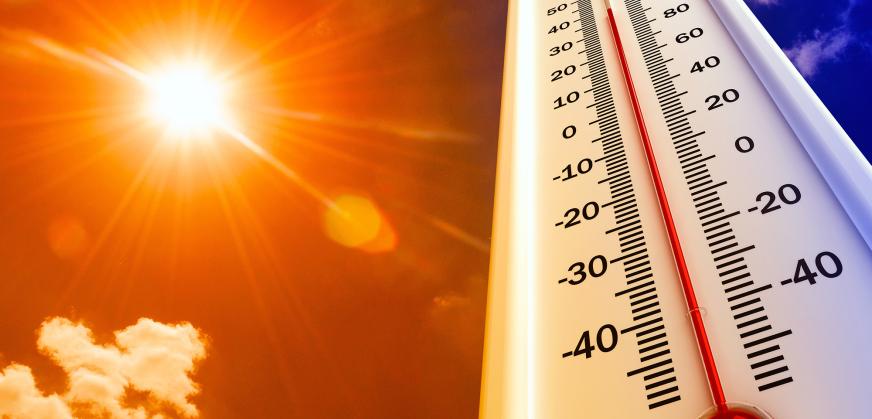Introduction to Weathering
Blog
Last Updated 2023
What Is Weathering?
Weathering and Lightstability
Weathering refers to changes in material properties that result from exposure to the radiant energy present in sunlight, in combination with heat (including temperature cycling), and water in its various states, predominately as humidity, dew, and rain. These three elements of outdoor exposure – sunlight, heat, and water - are referred to as the “Forces of Weathering.” Weathering degradation is typically initiated by sunlight, and can be accelerated by heat and affected by the presence of water.
A closely-related concept is lightstability, or lightfastness, which refers to a material’s ability to withstand two of the three forces of weathering - sunlight and heat. Lightstability testing does not involve liquid water, and often is used to test textiles and indoor materials. Q-Lab's introduction to Sunlight, Weathering, and Lightstability explains further the similarities and differences between them.
Weathering and lightstability can result in many different types of material degradation, including yellowing, cracking, crazing, color change and fading, delamination and adhesion loss, warping, embrittlement, blistering, and loss of tensile strength. The image below shows a number of different types of material property change resulting from exposure to outdoor conditions.
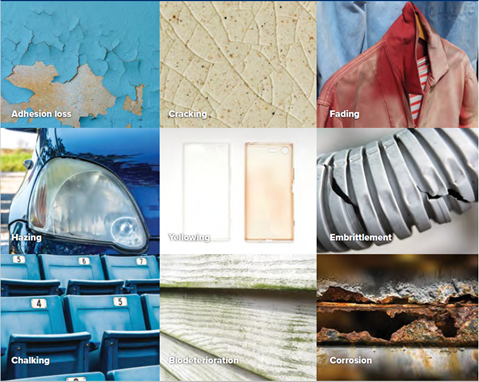
Weathering and light degradation affect a broad range of materials and industries – effectively, any products placed in service outdoors or otherwise exposed to the elements. This includes paints and coatings, plastics, packaging, textiles and fabrics, home and consumer goods, additives and colorants, architectural and building materials, inks and printing materials, electronics, and an array of automotive components. Browse our weathering industries pages and case studies for examples of weathering durability testing, or check out this general testing guide.
Forces of Weathering
When we talk about sunlight as one of the forces of weathering, we are usually concerned with ultraviolet (UV) light. Although it represents only about 7% of the sun’s total energy, UV is responsible for virtually all polymer degradation. The character of the sunlight received by products outdoors depends on a number of factors – time of year, time of day, latitude, cloud cover, and altitude. Additionally, window glass filters out some shortwave UV light, depending on its thickness and tint, resulting in a less harsh light spectrum than materials outdoors. The spectral sensitivity of materials is also critical – for materials degradation to occur, the material must be able to absorb the incident light, and the light must have enough energy to cause chemical bonds to break.
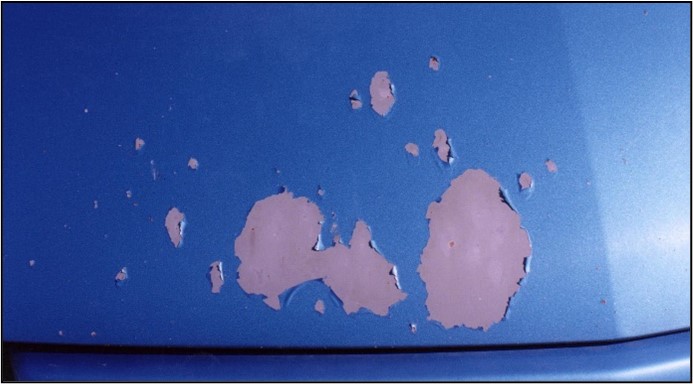
Heat, both in the form of high temperatures and thermal cycling, can accelerate outdoor property changes. Photochemical reactions caused by incident sunlight are not usually simple one-step reactions. Although the primary reactions caused by sunlight are not affected by heat, secondary reactions often are. In some cases, a 10 °C increase in temperature can double the rate of some chemical reactions in solution. Thermal cycling outdoors can change a material's surface temperature from 75 °C to 25 °C in a matter of minutes, causing physical stress on assemblies and coatings.
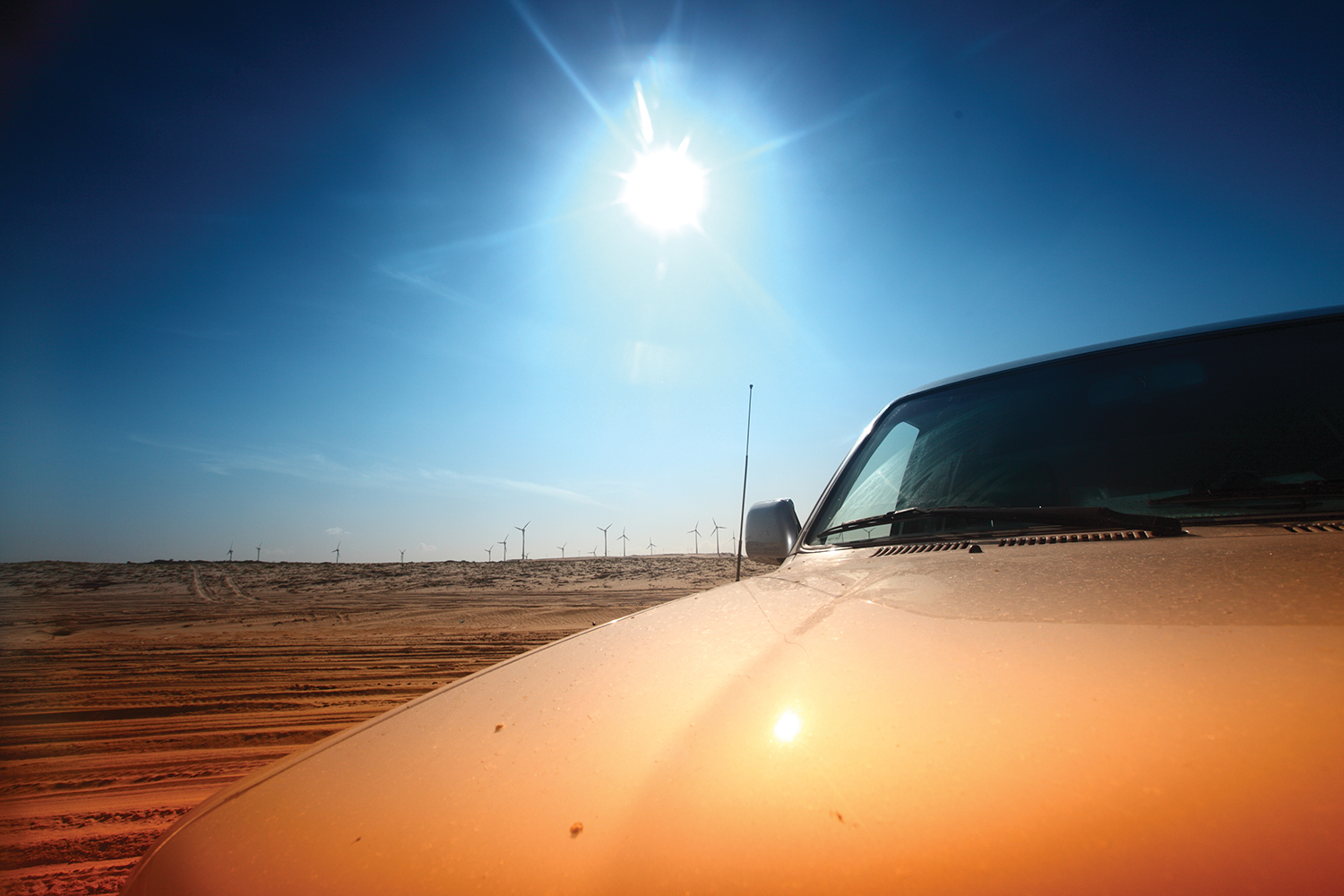
Water can affect materials degradation in a number of ways. Water can affect chemical reactions – both accelerating reactions in solution and leading to an increase in oxygen transport. Water can also cause physical effects like erosion, absorption, freeze/thaw stress, thermal shock, and material loss from impact.
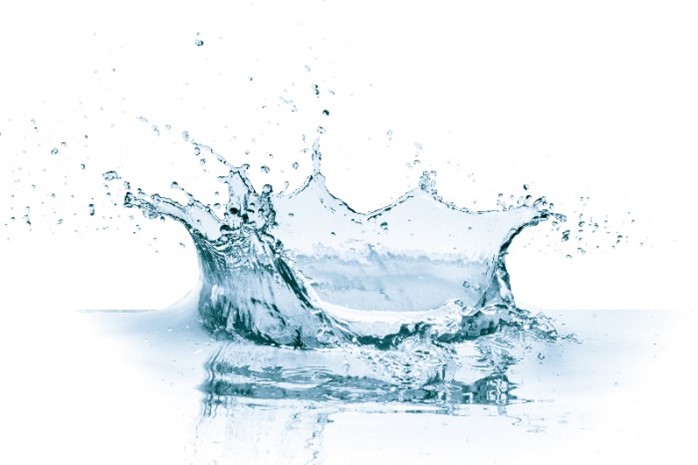
Water can be present in the form of dew (condensation), relative humidity, and rainfall. Of these, dew is by far the largest source of outdoor moisture. Materials outdoors can be wet for over 12 hours a day in many locations, so designing for outdoor performance means designing for an aqueous environment.
The synergistic effects of sunlight, heat, and water are what result in weathering of materials; sunlight and heat resistance determine a material’s lightfastness. How can we make sure our products will last outdoors? The answer is: weathering testing.
How Do I Perform Weathering Testing?
There are two fundamental types of weathering testing: natural outdoor testing, and accelerated laboratory testing. These two test types are complementary and, performed together, make up a complete weathering test program. Q-Lab can help you determine the best comprehensive test plan for your products and materials.
Natural Outdoor Testing
Natural outdoor testing at our benchmark test locations in Florida and Arizona is the best way to establish the outdoor durability of your products. Florida and Arizona are internationally-recognized benchmark locations for outdoor exposure testing. Florida subtropical weathering exposures are not only realistic, they are also accelerated. South Florida exposures deliver high-intensity sunlight, high annual ultraviolet (UV) light, high temperatures year-round, abundant rainfall, and very high humidity. Arizona features even higher-intensity sunlight, hotter temperatures, and dry, desert conditions. For an overview of natural outdoor testing, see our webinar Natural Outdoor Weathering Testing.
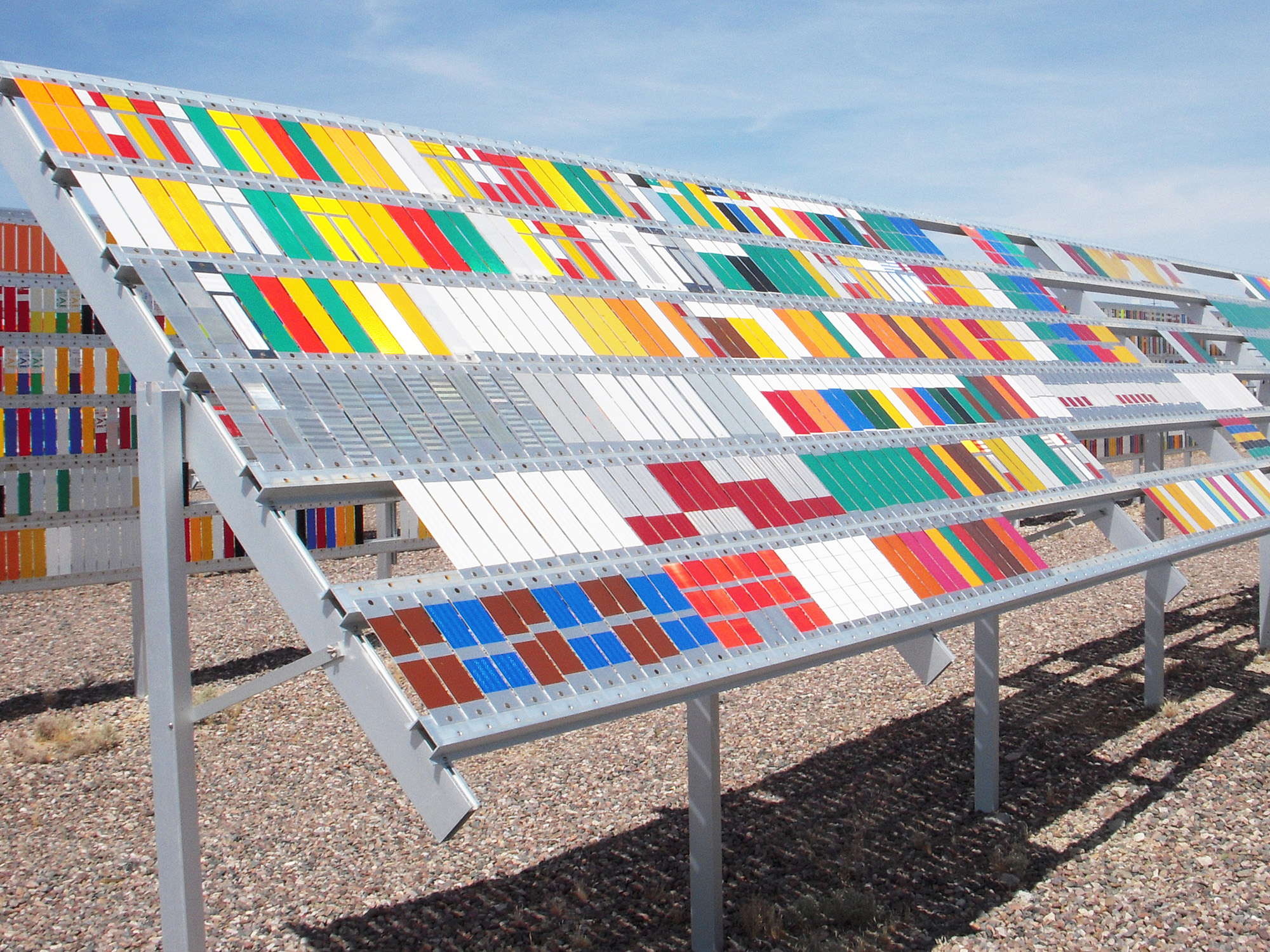
The synergistic effect of UV, moisture, and heat makes Florida the ideal location for testing durability of materials in outdoor environments. Arizona’s high levels of sunshine and heat make it the ideal location for testing highly durable materials that may not fail elsewhere. Natural outdoor weathering is the most accurate way to understand the durability of materials outdoors and is the cornerstone of any comprehensive weathering testing program. We recommend that all manufacturers of products used outdoors should:
- Test at benchmark sites, since harsh environments accelerate degradation for low cost
- Start new outdoor tests every year (or more frequently) to develop a library of data and compare new formulations to old products and competitors’ materials
- Qualify and validate accelerated lab testing with outdoor data – “test the test”
Accelerated Laboratory Testing
Although natural outdoor testing is the most true and accurate way to conduct weathering test exposures, testing can take a long time – 5, 10, even 20 or more years for highly-durable materials. Accelerated laboratory weathering testing can help with this. By accelerating the forces of weathering in a controlled lab environment, you can get faster results about product durability. Accelerated weathering testing is fast, repeatable, and convenient, and is great for quality control, qualification, and research & development. It is a “tool for directional decision-making,” to help better determine:
- What ingredients to include or not include in a product
- Whether a lot or batch is OK to ship to customers
- What vendors to buy from
- Which processing and manufacturing parameters should be selected
There are two primary types of accelerated weathering testing, which offer complementary benefits as described in QUV and Q-SUN: A Comparison. For a summary of the forces of weathering and these two test architectures, see our webinar Essentials of Laboratory Weathering.
One is fluorescent UV weathering testing using the QUV Accelerated Weathering Tester. To simulate outdoor weathering, the QUV accelerated weathering tester exposes materials to alternating cycles of UV light and moisture at controlled, elevated temperatures. It simulates the effects of natural sunlight and artificial irradiance using special fluorescent UV lamps that deliver light from only the UVA, UVB, and UVC portions of the spectrum. It simulates dew and rain with condensing humidity and/or water spray.

The other principal test architecture for accelerated weathering and lightfastness testing is xenon arc weathering testing. Q-SUN xenon arc test chambers reproduce the damage caused by full-spectrum sunlight, heat, and rain. One or more xenon arc lamps are used in Q-SUN testers to generate a spectrum very similar to the complete spectrum of outdoor sunlight. Optical filters are used to deliver light spectra tailored to the product’s service environment. Elevated temperatures are generated by the lamps and controlled by black panel thermometers and chamber air temperature control. Moisture is delivered to specimens primarily by water spray, in addition to controlled relative humidity. Rotating rack and flat array testers are both expressly permitted in nearly every major standard, and research studies have confirmed that they deliver similar results in many cases.

Accelerated Outdoor Testing
To combine the realism of outdoor exposure with the fast results of laboratory testing, accelerated outdoor testing is also available using the Q-TRAC Natural Solar Concentrator or the Automotive Interior Materials (AIM) box. For an overview of these tests, see our webinar Accelerated Outdoor Weathering Testing.
The Q-TRAC solar concentrator uses actual sunlight as the light source and is exceptionally useful for testing highly-durable materials with exceptionally long lifetime expectations. It uses an array of 10 mirrors to reflect and concentrate full-spectrum sunlight onto test specimens while tracking the sun throughout the day to maximize the amount of solar exposure that test specimens receive. The Q-TRAC solar concentrator also has a water spray system, which can perform cycles that simulate Florida weathering or create thermal shock.
AIM Box testing exposes automotive interior materials to high temperatures and outdoor sunshine behind clear or laminated glass, to simulate the conditions inside an automobile. AIM boxes can also track the sun during the day to increase the amount of solar radiation products receive.
Why Perform Weathering Testing?
Reasons to Test
At Q-Lab, we often ask the question “Will Your Products Last Outdoors?” and respond with “Don’t Guess When You Can Test!” That said, what are the actual benefits of weathering and lightstability testing? Here are just a few:
Improve your product’s durability
Weathering testing has resulted in drastic increases in the lifetime of many important products. Take, for example, automotive coatings, where weathering testing has supported developments leading to over a 100% increase in product lifespan.
Save on material costs
The right materials selection can have a crucial impact on product performance – and your bottom line. How much would it save you if you bought raw materials that were 10% cheaper and your performance was unaffected? Proper materials selection can save hundreds of thousands of dollars in some cases, and weathering testing gives you the confidence to make the right choice.
Avoid catastrophic field failures
On the other hand, how much would it cost you if you bought 10% cheaper raw materials, but it made your product fail in service? Lawsuits and large-scale warranty claims can be very damaging to a company’s profits and reputation. Testing helps avoid such mistakes.
Many more!
Weathering and lightstability testing can help you meet customer specifications, enhance your marketplace reputation, verify supplier claims, expand your existing product lines, enter new markets, outpace the competition, and stay ahead of government regulations.
Test Types
It’s important to understand that not all weathering test types have the same goals. A test program should be developed with a clear understanding of what knowledge is critical to gain. The testing matrix below shows different categories of testing from simplest to most complex:
| Accelerated Test Types | Results | Test Time | Results Compared to |
|---|---|---|---|
| Quality Control | Pass/Fail |
| Material Specifications |
| Qualification/Validation | Pass/Fail |
| Reference Material or Specification |
| Correlative | Rank-ordered Data |
| Natural Exposure (Benchmark site) |
| Predictive | Service Life Acceleration Factor |
| Natural Exposure (Service Environment) |
Most weathering testing, at least to begin with, is quality control testing – short, defined screening tests for fixed time intervals that generate pass/fail results. This is closely related to qualification or validation testing, where a customer’s specification needs to be met in a test in order to gain acceptance. Correlative and predictive testing require outdoor data and therefore are part of a broader test program. Correlative testing uses outdoor data as a reference to “rank order” specimens in lab testing – in other words, to determine which are the highest performers and which are less weathering-resistant. Predictive testing gives estimates of service life based on lab results, but is highly material-specific, test-specific, and failure mode-specific, and requires lots of outdoor test data.
Correlation
The most common question we receive at Q-Lab is some variation of “how many hours in an accelerated weathering tester corresponds to (5, 10, 20) years outdoors?”
The short answer is that there is no simple, general relationship between laboratory and accelerated weathering testing. The problem is not that we just haven’t developed the perfect weathering tester yet. No matter how sophisticated or expensive you make your weathering tester, you still won’t find the “magic number.” The biggest problem is the inherent variability and complexity of outdoor exposure situations, including geography, weather variability, service environment, test conditions, and many more. Reciprocity, the concept that an increase in irradiance intensity leads to a proportional decrease in test time, typically does not hold. Additionally, simply comparing tests by the amount of radiant dosage can lead to errors, especially for light sources with different spectral characteristics.
However, the rank-order data that can be generated by a comprehensive outdoor and accelerated weathering test plan is extremely valuable information that can tell you a lot about product durability. At Q–Lab, we’re here to help you get the most out of your testing program with the least possible hassle: it’s why we say that We Make Testing Simple.
